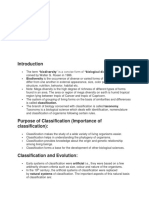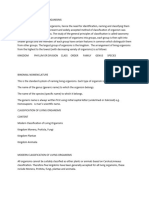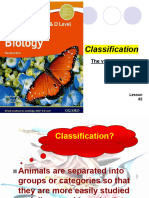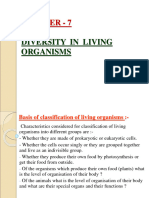Animal Kingdom: Biology
Animal Kingdom: Biology
Uploaded by
Harsh SarafCopyright:
Available Formats
Animal Kingdom: Biology
Animal Kingdom: Biology
Uploaded by
Harsh SarafOriginal Description:
Original Title
Copyright
Available Formats
Share this document
Did you find this document useful?
Is this content inappropriate?
Copyright:
Available Formats
Animal Kingdom: Biology
Animal Kingdom: Biology
Uploaded by
Harsh SarafCopyright:
Available Formats
Biology is a natural science concerned with the study of life and living organisms, including their structure, function,
growth, evolution, distribution, and taxonomy.[1] Biology has many subdisciplines unified by five so-called axioms of modern biology:[2] 1.Cells are the basic unit of life 2.Genes are the basic unit of heredity 3.New species and inherited traits are the product of evolution 4.An organism regulates its internal environment to maintain a stable and constant condition 5.Living organisms consume and transform energy Subdisciplines of biology are defined by the scale at which organisms are studied and the methods used to study them: biochemistry examines the rudimentary chemistry of life; molecular biology studies the complex interactions among biological molecules; cellular biology examines the basic building block of all life, the cell; physiology examines the physical and chemical functions of tissues, organs, and organ systems of an organism; evolutionary biology examines the processes that produced the diversity of life; and ecology examines how organisms interact in their environment.[3]
ANIMAL KINGDOM
The Animal Kingdom Approximately two million different species of animals have been identified on Planet Earth and ten thousand more species of animals are discovered every year. They have been classified into nine major phylaeight phyla being invertebrates (animals without a backbone). The one phylum of vertebrates (animals with a backbone) is further classified into five different classesmammals, birds, fish, reptiles and amphibians. Sounds complicatednot really! In order for scientist to discover and study animals they must be classified into a group according to resemblance and differences using pre-established rules. The branch of science which deals with the classification is called taxonomy or systematic zoology.
The Taxonomy System Kingdom Animalia is the largest of the five existing kingdoms on Planet Earth. The scientific classification system is divided into seven major groups, (1) kingdom, (2) phylum or division, (3) class, (4) order, (5) family, (6) genus, and (7) species. The kingdom is the largest group and a species is the smallest. In the Animal Kingdom, the term phylum is used, and it is the second largest group. Classes have more characteristics in common than animals in a division or phylum. For example, amphibians, reptiles, and birds belong to the phylum Chordata. However, each of the animals belong to a different class. Amphibians belong to the class of Amphibia which consist of frogs, toads and salamanders. Reptiles belong to the class Reptilia which consist of snakes, crocodiles and alligators. Birds belong to the class Aves. An order is made up of animals that have more features alike that those in a class. In the class Mammalia, all animals produce milk for their young. Cats, dogs, raccoons and shrew are all mammals. Dogs, cats and raccoons eat flesh are grouped together in an order called Carnivora with other flesh-eating animals. Shrews eat insects, and are classified in the order insectivora with other insecteating animals. A family consists of animals that are even more alike than those in an order. Wolves and cats are both in order Carnivora. But wolves belong to the family Canidae and cats belong to the family Felidae. The family Canidae consist of animals with long snouts and bushy tails, whereas animals in the family Felidae have short snouts and short-haired tails. A genus consists of animals with very similar groups, but members of different groups usually cannot breed with one another. Both the coyote and the timber wolf belong to the genus Canis. But coyotes and timber wolves generally do not breed with one another. A species is the basic units of scientific classification. Animals of a species have many similar features and characteristics alike, but
they are different from all forms of life in one or more ways. Members within a species can breed with one another, and their young grow to look very much like the parents. Each member in a species is assigned a scientific name. The coyotes scientific name is Canis latrans, and the gray wolf is Canis lupus. Scientist sometimes group animals within a species into even smaller groups because they have another distinctive feature. These groups are called subspecies or varlebes.
About animal Kingdom
An invertebrate is an animal without a backbone or vertebral column. The vertebral column are made up of small bones called vertebrae. The scientific name assigned to animals without backbones is Invertebrata, meaning without vertebrae. There are more than one million known species of invertebrate and about forty thousand species of vertebrate animals. Due to the large variety of invertebrates, scientists have divided them into seven major groups called phyla. The phylum Echinodermata consist of a group of animals with external spines, such as the sand dollar, starfish, sea urchin, Portuguese-man-of-war, and the sea cucumber. The phylum Porifera contain animals with pores all over their bodies known as sponges. The phylum Coelenterata, also called Cnidaria includes animals such as the hydra, jellyfish, sea anemone, and the coral. These animals are characterized by having special stinging organs called nematocysts. The phylum Mollusca is made up of animals called mollusks. Some examples of mollusks include snails, slugs, scallop, octopus and clams. These animals are characterized as having soft body and usually have limy shells. There are three different phyla of worms, the Platyhelminthes,
Annelida, and Nematoda. The phylum Platyhelminthes include worms with flattened bodies, such as the planarian, tapeworm and liver fluke. Phylum Nematoda include all the roundworms such as the ascaris, pinworm, hookworm, stomach worm and the trichina or pork worm. Phylum Annelida includes worms with bodies made of segments such as the sandworm, leech and the earthworm. Phylum Arthropoda is the largest of all the phyla of animals according to the number of species in this particular group. Arthropods are characterized as animals with jointed legs and a hard external skeleton made of chitin. Animals in this group include spiders, insects and crustaceans. Unlike the invertebrates, vertebrate animals have a backbone. Most vertebrates have a spinal column made up of tiny bones called vertebrae. However, some vertebrates do not have a spinal column made up of tiny rigid bones. Animals such as the shark have a vertebrae made up of cartilage. All vertebrates are bilaterally symmetrical meaning that the left and right sides of the body are alike. Their bodies are usually divided into a head and trunk. There are about forty thousand species of vertebrates placed into one phylum, Chordata, which is divided into eight different classes: (1) class Aves (birds), (2) class Fish, (3) class Reptilia (reptiles), (4) class Mammalia (mammals), (5) class Amphibia (amphibians).
PLANT KINGDOM:
Plants, also called green plants (Viridiplantae in Latin), are living organisms of the kingdom Plantae including such multicellular groups as flowering plants, conifers, ferns and mosses, as well as, depending on definition, the green algae, but not red or brown seaweeds like kelp, nor fungi or bacteria. Green plants have cell walls with cellulose and characteristically obtain most of their energy from sunlight via photosynthesis using chlorophyll contained in chloroplasts, which gives them their green color. Some plants are parasitic and have lost the ability to produce normal amounts of
chlorophyll or to photosynthesize. Plants are also characterized by sexual reproduction, modular and indeterminate growth, and an alternation of generations, although asexual reproduction is common, and some plants bloom only once while others bear only one bloom. Precise numbers are difficult to determine, but as of 2010, there are thought to be 300315 thousand species of plants, of which the great majority, some 260290 thousand, are seed plants (see the table below).[2] Green plants provide most of the world's molecular oxygen and are the basis of most of the earth's ecologies, especially on land. Plants described as grains, fruits and vegetables form mankind's basic foodstuffs, and have been domesticated for millennia. Plants serve as ornaments and, until recently and in great variety, they have served as the source of most medic
Algae
Green algae from Ernst Haeckel's Kunstformen der Natur, 1904.
Main article: Algae Algae comprise several different groups of organisms which produce energy through photosynthesis and for that reason have been included in the plant kingdom in the past. Most conspicuous among the algae are the
seaweeds, multicellular algae that may roughly resemble land plants, but are classified among the brown, red and green algae. Each of these algal groups also includes various microscopic and single-celled organisms. There is good evidence that some of these algal groups arose independently from separate non-photosynthetic ancestors, with the result that many groups of algae are no longer classified within the plant kingdom as it is defined here.[6][7] The Viridiplantae, the green plants green algae and land plants form a clade, a group consisting of all the descendants of a common ancestor. With a few exceptions among the green algae, all green plants have many features in common, including cell walls containing cellulose, chloroplasts containing chlorophylls a and b, and food stores in the form of starch. They undergo closed mitosis without centrioles, and typically have mitochondria with flat cristae. The chloroplasts of green plants are surrounded by two membranes, suggesting they originated directly from endosymbiotic cyanobacteria. Two additional groups, the Rhodophyta (red algae) and Glaucophyta (glaucophyte algae), also have chloroplasts which appear to be derived directly from endosymbiotic cyanobacteria, although they differ in the pigments which are used in photosynthesis and so are different in colour. All three groups together are generally believed to have a single common origin, and so are classified together in the taxon Archaeplastida, whose name implies that the chloroplasts or plastids of all the members of the taxon were derived from a single ancient endosymbiotic event. This is the broadest modern definition of the plants. In contrast, most other algae (e.g. heterokonts, haptophytes, dinoflagellates, and euglenids) not only have different pigments but also have chloroplasts with three or four surrounding membranes. They are not close relatives of the Archaeplastida, presumably having acquired chloroplasts separately from ingested or symbiotic green and red algae. They are thus not included in even the broadest modern definition of the plant kingdom, although they were in the past. The green plants or Viridiplantae were traditionally divided into the green algae (including the stoneworts) and the land plants. However, it is now known that the land plants evolved from within a group of green algae, so that the green algae by themselves are a paraphyletic group, i.e. a group which excludes some of the descendants of a common ancestor. Paraphyletic groups are generally avoided in modern classifications, so that in recent treatments the Viridiplantae have been divided into two clades, the Chlorophyta and the Streptophyta (or Charophyta).[8][9] The Chlorophyta (a name that has also been used for all green algae) are
the sister group to the group from which the land plants evolved. There are about 4,300 species[10] of mainly marine organisms, both unicellular and multicellular. The latter include the sea lettuce, Ulva. The other group within the Viridiplantae are the mainly freshwater or terrestrial Streptophyta (or Charophyta), which consist of several groups of green algae plus the stoneworts and land plants. (The names have been used differently, e.g. Streptophyta to mean the group which excludes the land plants and Charophyta for the stoneworts alone or the stoneworts plus the land plants.) Streptophyte algae are either unicellular or form multicellular filaments, branched or unbranched.[9] The genus Spirogyra is a filamentous streptophyte alga familiar to many, as it is often used in teaching and is one of the organisms responsible for the algal "scum" which pond-owners so dislike. The freshwater stoneworts strongly resemble land plants and are believed to be their closest relatives. Growing underwater, they consist of a central stalk with whorls of branchlets, giving them a superficial resemblance to horsetails, species of the genus Equisetum, which are true land plants.
Fungi
Main article: Fungi The classification of fungi has been controversial until quite recently in the history of biology. Linnaeus' original classification placed the fungi within the Plantae, since they were unquestionably not animals or minerals and these were the only other alternatives. With later developments in microbiology, in the 19th century Ernst Haeckel felt that another kingdom was required to classify newly discovered micro-organisms. The introduction of the new kingdom Protista in addition to Plantae and Animalia, led to uncertainty as to whether fungi truly were best placed in the Plantae or whether they ought to be reclassified as protists. Haeckel himself found it difficult to decide and it was not until 1969 that a solution was found whereby Robert Whittaker proposed the creation of the kingdom Fungi. Molecular evidence has since shown that the last common ancestor (concestor) of the Fungi was probably more similar to that of the Animalia than of any other kingdom, including the Plantae. Whittaker's original reclassification was based on the fundamental difference in nutrition between the Fungi and the Plantae. Unlike plants, which generally gain carbon through photosynthesis, and so are called autotrophic phototrophs, fungi generally obtain carbon by breaking down and absorbing surrounding materials, and so are called heterotrophic saprotrophs. In addition, the substructure of multicellular fungi is different from that of plants, taking the form of many chitinous microscopic strands called hyphae, which may be further subdivided into cells or may form a
syncytium containing many eukaryotic nuclei. Fruiting bodies, of which mushrooms are most familiar example, are the reproductive structures of fungi, and are unlike any structures produced by plants. ines and drugs. Their scientific study is known as botany.
HUMAN LIFE
Humans (variously Homo sapiens and Homo sapiens sapiens) are primates of the family Hominidae, and the only extant species of the genus Homo.[2][3] Humans are distinguished from other animals by a relatively larger brain with a particularly well developed neocortex, prefrontal cortex and temporal lobes; enabling high levels of abstract reasoning, language, introspection, problem solving, culture through social learning, and other important mental capabilities which, combined with bipedal locomotion that frees the hands for manipulating objects, has allowed far greater use of tools than any other species. Humans are the only extant species known to build fires and cook their food, as well as the only known species to clothe themselves and create and use numerous other technologies and arts. The scientific study of humans is the discipline of anthropology. Humans are uniquely adept at utilizing systems of symbolic communication such as language and art for self-expression, the exchange of ideas, and organization. Humans create complex social structures composed of many cooperating and competing groups, from families and kinship networks to states. Social interactions between humans have established an extremely wide variety of values, social norms, and rituals, which together form the basis of human society. Humans are noted for their desire to understand and influence their environment, seeking to explain and manipulate phenomena through science, philosophy, mythology, and religion. Homo sapiens originated in Africa, where it reached anatomical modernity about 200,000 years ago and began to exhibit full behavioral modernity around 50,000 years ago.[4] The human lineage diverged from the last common ancestor with its closest living relative, the chimpanzee, some five million years ago, evolving into the Australopithecines and eventually the genus Homo.[5] The first Homo species to move out of Africa was Homo erectus, the African variety of which, together with Homo heidelbergensis, is considered to be the immediate ancestor of modern humans.[6][7] Homo sapiens proceeded to colonize the continents, arriving in Eurasia 125,000 60,000 years ago,[8][9] Australia around 40,000 years ago, the Americas around 15,000 years ago, and remote islands such as Hawaii, Easter Island, Madagascar, and New Zealand between the years AD 300 and 1280.[10][11]
Humans began to practice sedentary agriculture about 12,000 years ago, domesticating plants and animals which allowed for the growth of civilization. Humans subsequently established various forms of government, religion, and culture around the world, unifying people within a region and leading to the development of states and empires. The rapid advancement of scientific and medical understanding in the 19th and 20th centuries led to the development of fuel-driven technologies and improved health, causing the human population to rise exponentially. With individuals widespread in every continent except Antarctica, humans are a cosmopolitan species, and by 2012, their population was estimated to be around 7 billion.[12][13]
0-6 MONTHS 6-1YR 1-12 13-19 19-21 21-40 40-60 60+
INFANT BABY CHILD TEENAGER ADOLOSCENT ADULT MIDDLE AGED OLD
You might also like
- Common Schemes Grade 10 GeographyDocument13 pagesCommon Schemes Grade 10 GeographyAdminstrator InternNo ratings yet
- Hol - Lab1 PDFDocument6 pagesHol - Lab1 PDFVictor Hugo Calvanapón Salas100% (1)
- Plant KingdomDocument9 pagesPlant KingdomsanaullahNo ratings yet
- Sci 8 4TH Quarter Module 6Document35 pagesSci 8 4TH Quarter Module 6Diosa BakingNo ratings yet
- Linnaeuss System of ClassificationDocument33 pagesLinnaeuss System of Classificationheartyjune.ortizo0610No ratings yet
- Definition and Classification, Exemplification Text, Arado, BrettniaDocument5 pagesDefinition and Classification, Exemplification Text, Arado, BrettniaShiela JoyNo ratings yet
- Science PRTDocument11 pagesScience PRTTykes xiumNo ratings yet
- P PPPPPPPPPPP ! P "!PPP P!P P !P!"PP "P P#P " PP P$%P PP "&P'" PP" " !P#P PP P (!P"PPPP) PP"PP!P PPPP &P'"P PP P! PP PP!P&PDocument4 pagesP PPPPPPPPPPP ! P "!PPP P!P P !P!"PP "P P#P " PP P$%P PP "&P'" PP" " !P#P PP P (!P"PPPP) PP"PP!P PPPP &P'"P PP P! PP PP!P&PRaina Abad AnchetaNo ratings yet
- COL3Document11 pagesCOL3Clefford CorporalNo ratings yet
- Five Kingdom SystemDocument8 pagesFive Kingdom SystemsanaullahNo ratings yet
- Diversity of Living ThingsDocument40 pagesDiversity of Living Thingsmartinaddy2004No ratings yet
- Animalia KingdomDocument11 pagesAnimalia KingdomAnthony PattungNo ratings yet
- B.sc. I Detailed ClassificationDocument9 pagesB.sc. I Detailed ClassificationSuchitra SharmaNo ratings yet
- Beta Monic Ai-MonicaiDocument6 pagesBeta Monic Ai-MonicaiJAYAKUMARNo ratings yet
- (Biol 12) Grade 9 - Unit 5 Notes and MCQ (2016)Document18 pages(Biol 12) Grade 9 - Unit 5 Notes and MCQ (2016)Bekele GonfaNo ratings yet
- "Biodiversity" Is A Concise Form of "Biological Diversity" and Was Biodiversity Is The Occurrence of Diverse or Varied Forms of Living Beings WhichDocument11 pages"Biodiversity" Is A Concise Form of "Biological Diversity" and Was Biodiversity Is The Occurrence of Diverse or Varied Forms of Living Beings Whichbrm1shubhaNo ratings yet
- Classification OF LIVING ORGANISMSDocument10 pagesClassification OF LIVING ORGANISMSBamideleNo ratings yet
- Chapter 2 (Biology)Document12 pagesChapter 2 (Biology)MahendraKumarNo ratings yet
- Bio 111-1Document13 pagesBio 111-1efep478No ratings yet
- TaxonomyDocument19 pagesTaxonomyErica A.No ratings yet
- Cellular MorphologyDocument31 pagesCellular Morphologypravar2762No ratings yet
- Classification of Living OrganismsDocument23 pagesClassification of Living OrganismsbrajanosmaniNo ratings yet
- TaxonomicDocument51 pagesTaxonomicAlvin OliverosNo ratings yet
- Binomial Nomenclature and CladisticsDocument31 pagesBinomial Nomenclature and CladisticsJaymark HisonaNo ratings yet
- Diversity in Living OrganismsDocument33 pagesDiversity in Living Organismspravar2762No ratings yet
- REVIEW Year 6 1st T PDFDocument25 pagesREVIEW Year 6 1st T PDFizaNo ratings yet
- ClassificationDocument40 pagesClassificationSajed- JRNo ratings yet
- Chapter-2 (Biology)Document24 pagesChapter-2 (Biology)pramod peterNo ratings yet
- Group 3: Kingdom AnimaliaDocument23 pagesGroup 3: Kingdom AnimaliabrettNo ratings yet
- General Biology - Chapter IDocument10 pagesGeneral Biology - Chapter IG.k. Vinnan Rao100% (2)
- Chrizza Ville Cayasan Ashleyril Dingal Breana Sophia Oliveros Ciellinneth Cielo Sarah Laine VicenteDocument7 pagesChrizza Ville Cayasan Ashleyril Dingal Breana Sophia Oliveros Ciellinneth Cielo Sarah Laine Vicentechrizza ville cayasanNo ratings yet
- Carolus LinnaeusDocument5 pagesCarolus LinnaeusMae Jane AguilarNo ratings yet
- Biology Notes Biodiversity Class 9thDocument18 pagesBiology Notes Biodiversity Class 9thKaka KNo ratings yet
- Session 3Document5 pagesSession 3KESHAVA MURTHY M VNo ratings yet
- RPG Formula ForceDocument9 pagesRPG Formula Forceyuvraj129598No ratings yet
- Diversity in Living OrganismsDocument7 pagesDiversity in Living Organismssumendra singhNo ratings yet
- Class Note On Classification of Living Things (Monera & Protista)Document7 pagesClass Note On Classification of Living Things (Monera & Protista)Ayodele EmmanuelNo ratings yet
- The Linnaean System of ClassificationDocument9 pagesThe Linnaean System of Classificationzhuldyz.ayupova77No ratings yet
- Living World Class XiDocument32 pagesLiving World Class XivijithamuraliNo ratings yet
- General ZoologyDocument22 pagesGeneral Zoologytonie rose abeNo ratings yet
- Year OverviewDocument7 pagesYear OverviewJack NavinNo ratings yet
- Stages of Living ThingsDocument18 pagesStages of Living ThingsJay DansNo ratings yet
- Introduction To Taxonomy: DiversityDocument12 pagesIntroduction To Taxonomy: DiversityRajesh Kumar GuptaNo ratings yet
- Nature BookDocument25 pagesNature Bookpragathish83No ratings yet
- Fungus KingdomDocument24 pagesFungus KingdomKayla-may MollisonNo ratings yet
- Bio CH 7Document6 pagesBio CH 7Madhur SharmaNo ratings yet
- Hierarchical TaxonomicDocument24 pagesHierarchical TaxonomicJoedee NicolasNo ratings yet
- Classification of Living OrganismsDocument37 pagesClassification of Living OrganismsSweeetMimiNo ratings yet
- The Animal KingdomDocument17 pagesThe Animal KingdomJimmy Alvarez Romero100% (1)
- Kingdom of AnimaliaDocument8 pagesKingdom of AnimaliaAlanie ElnarNo ratings yet
- Classification of Living OrganismsDocument29 pagesClassification of Living OrganismsOJ ICONICNo ratings yet
- Unit 5 Classification-Class NotesDocument18 pagesUnit 5 Classification-Class NotesNatasha AgarwalNo ratings yet
- Invertebrates AntonetteDocument27 pagesInvertebrates Antonetteduganirene1No ratings yet
- Zoology AssignmentDocument9 pagesZoology AssignmentpoorvagangauNo ratings yet
- Animal Kingdom ClassificationDocument20 pagesAnimal Kingdom Classificationsarvesh672No ratings yet
- Classification - Taxonomy ReadingDocument7 pagesClassification - Taxonomy Readingapi-262368188No ratings yet
- SILENT READING ACTIVITY Grade 8 Module 3Document4 pagesSILENT READING ACTIVITY Grade 8 Module 3Anthony IlustreNo ratings yet
- Bab IiiDocument3 pagesBab IiiVenty HabibieNo ratings yet
- Text 2 Classification of Living ThingsDocument3 pagesText 2 Classification of Living ThingsmisterxNo ratings yet
- Zoology BonDocument118 pagesZoology BonRupkathar Pagol Kra RajkumariNo ratings yet
- CH 7.2 Plant Kingdom Diversities 1 3Document16 pagesCH 7.2 Plant Kingdom Diversities 1 3Shreyash Mitra Educational PurposeNo ratings yet
- Capacity HistoryDocument19 pagesCapacity HistoryHarsh SarafNo ratings yet
- Deloitte Fashioning Sustainability 2013Document24 pagesDeloitte Fashioning Sustainability 2013Harsh SarafNo ratings yet
- Business As Unusual The Role of National Cultural Background in Corporate LifeDocument8 pagesBusiness As Unusual The Role of National Cultural Background in Corporate LifeHarsh SarafNo ratings yet
- Special Report On MINT Countries:: ESG Issues in Mexico, Indonesia, Nigeria & TurkeyDocument10 pagesSpecial Report On MINT Countries:: ESG Issues in Mexico, Indonesia, Nigeria & TurkeyHarsh SarafNo ratings yet
- Graphical Representation of DataDocument6 pagesGraphical Representation of DataHarsh SarafNo ratings yet
- Yearly-Monitor of Civil Aviation StatisticsDocument2 pagesYearly-Monitor of Civil Aviation StatisticsHarsh SarafNo ratings yet
- Mountain DewDocument4 pagesMountain DewHarsh SarafNo ratings yet
- Harsh Saraf 683 Room No: 10: Functional ManagementDocument5 pagesHarsh Saraf 683 Room No: 10: Functional ManagementHarsh SarafNo ratings yet
- Aristotle's Biology and MetaphysicsDocument7 pagesAristotle's Biology and MetaphysicsVuk SuboticNo ratings yet
- Aleister Crowley - Liber 536 Batrachophrenoboocosmomachia Cd4 Id700699982 Size140Document6 pagesAleister Crowley - Liber 536 Batrachophrenoboocosmomachia Cd4 Id700699982 Size140André-Luiz TecelãoNo ratings yet
- YOGAS1Document6 pagesYOGAS1Narayana RemalaNo ratings yet
- Sample DisturbanceDocument29 pagesSample DisturbanceTheo Philus50% (2)
- Geophysical Evaluation of Magnetic Data of Okenugbo Area, Ago - Iwoye, Southwestern, NigeriaDocument8 pagesGeophysical Evaluation of Magnetic Data of Okenugbo Area, Ago - Iwoye, Southwestern, NigeriaSrikanth JutruNo ratings yet
- Theories On The Origin of The UniverseDocument9 pagesTheories On The Origin of The UniverseT DNo ratings yet
- CBSE XII Chemistry Project Spectroscopy and Its ApplicationsDocument21 pagesCBSE XII Chemistry Project Spectroscopy and Its ApplicationsRichie SinghNo ratings yet
- Illustrated Pica Trix ExtractDocument13 pagesIllustrated Pica Trix Extractmicheltrades22% (9)
- Atlas 1 PDFDocument516 pagesAtlas 1 PDFMercedes Amaya RosalesNo ratings yet
- Slake Durability Test of Rock MaterialDocument45 pagesSlake Durability Test of Rock MaterialChandan Kumar100% (1)
- Project 2061: Visions of Science, Visions of Ourselves by Mark D. Hartwig Dennis A. WagnerDocument17 pagesProject 2061: Visions of Science, Visions of Ourselves by Mark D. Hartwig Dennis A. WagnerlingarajugowdaNo ratings yet
- Edmund Husserl-Ideas II (Searchable Text)Document229 pagesEdmund Husserl-Ideas II (Searchable Text)Ali Mohsen100% (1)
- Extra Guidelines For Geography SBADocument4 pagesExtra Guidelines For Geography SBASurya GajadharsinghNo ratings yet
- Bitumen DahomeyDocument11 pagesBitumen DahomeyAhmad Invaluable AdenijiNo ratings yet
- Whittle ExtractiveBlendingDocument8 pagesWhittle ExtractiveBlendingMditsa1991No ratings yet
- KINEMATICS - Scientific PaperDocument8 pagesKINEMATICS - Scientific PaperDai VenusNo ratings yet
- CH 17Document16 pagesCH 17Iratechaos100% (3)
- Advanced Extragalactic Astrophysics - Exercise IDocument4 pagesAdvanced Extragalactic Astrophysics - Exercise ISimón ÁngelNo ratings yet
- Raffles Intimate KnowledgeDocument11 pagesRaffles Intimate Knowledgeaspj13No ratings yet
- Part I-Final Report On Soil InvestigationDocument16 pagesPart I-Final Report On Soil InvestigationmangjuhaiNo ratings yet
- Cut-Off Grade Estimation - QueensMineDesignWikiDocument7 pagesCut-Off Grade Estimation - QueensMineDesignWikiJean-Paul MwambaNo ratings yet
- Sea Water Intrusion in GreeceDocument13 pagesSea Water Intrusion in GreeceAnonymous BVbpSENo ratings yet
- Kingdom Biology WikipediaDocument9 pagesKingdom Biology WikipediaMission AidNo ratings yet
- FALL 2016 ASTRONOMY QUIZ 1 - Patterns in The Sky - Motions of The SkyDocument4 pagesFALL 2016 ASTRONOMY QUIZ 1 - Patterns in The Sky - Motions of The SkyVanessa JenkinsNo ratings yet
- 2 1 Ecosystem StructureDocument29 pages2 1 Ecosystem Structureapi-262369825No ratings yet
- MK-4 - Air Track Photogate Timing SystemDocument66 pagesMK-4 - Air Track Photogate Timing SystemRiski RamadaniNo ratings yet
- How Much Money Can You MakeDocument9 pagesHow Much Money Can You MakeKrishna Das CNo ratings yet
- San Beda College - Alabang College of Arts and Sciences: Alabang Hills Village, Muntinlupa CityDocument2 pagesSan Beda College - Alabang College of Arts and Sciences: Alabang Hills Village, Muntinlupa CityElla AlcantaraNo ratings yet

































































































